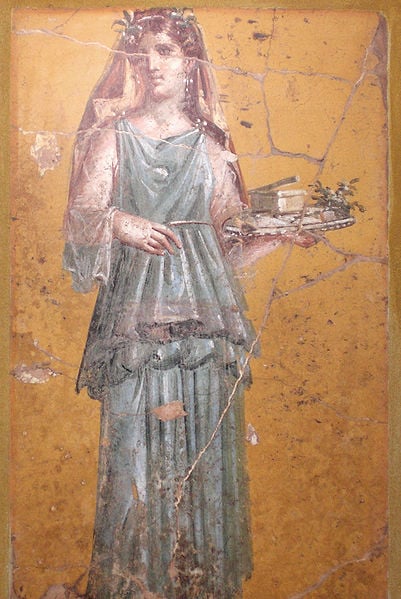By guest writer Isabelle Farineau
Instead of a post about my personal encounter with veiling, I thought it might be helpful to talk about some of this issues that tend to be forgotten in most discussions about veiling. If you do veil, or if you are considering it, I think that a little homework should be a pre-requisite for practice. If you have ever wondered about this increasingly popular practice as it exists in scripture and historical tradition I would say this post would be a good starting place, but that it is in no way comprehensive.
There are a variety of scholarly sources that you can consult on matters of biblical theology, anthropology, and the sociology of shared cultural affects like veiling. There is also the deplorable text by Tertullian, “On the Veiling of Virgins” which is so disturbing and problematic I haven’t even included it here, because it raises even more issues than I have time to address. In any case I want to make it clear that I presume to be neither a historian nor a biblical theologian – but that I encourage all of you to seek out some of these resources I mention and more to inform yourself about the background with has preceded this seemingly ‘trivial’ liturgical fashion.
From what I have gleaned from excessive (though unprofessional) research about the subject, it is hard to locate a central time or place when veiling definitively began. Our first major records of veiling in the western world are from tablets of Assyrian law. Veiling was mandatory for women of class but prohibited to the poor, prostitutes, and slaves. A woman of class who forgot her veil and a prostitute who dared to put one on were both subject to the same punishment: fifty blows and asphalt poured on her head. Not so bad, I suppose, by Assyrian standards (these are after all the same blokes who used to torture people using a practice called “the tub”- Google at your own risk).
This carried on into the Greek and Roman cultures, when women of the noble class would wear thick cloth veils that simultaneously denoted their higher class and their husband’s power over them. The latter association was so strong that removing a veil in ancient times was similar to a statement of divorce. This is St. Paul’s own background as a Roman when he speaks about veiling to Corinth. I believe it absolutely needs to be considered when we discuss what he wrote. What we are talking about here is the authority of a husband over his wife – that she should be covered and that is his responsibility to see to as well, that the veiling in some way makes her his own, and that there is no reciprocal motion on his part to denote his own marital status.
Rather, the man derives his authority from his not-being-veiled. This state of male authority demands by its definition that women be veiled so that men may appear as “not-veiled”. One must cover so that the other is in a state of being “not-covered”. Rather than disappear down a Heideggerian rabbit hole of hyphenations, I’d like to say simply that it boils down to this: a star-bellied sneetch is not so important or special without a non-starred sneetch to sneer at:
“Now, the Star-Belly Sneetches-
Had bellies with stars.
The Plain-Belly Sneetches-
Had none upon thars.”
(Dr. Seuss, The Sneetches)
If you choose to read only one thing I’ve quoted in this post, please let it be Seuss.
On the matter of men veiling, which Paul addresses in his passage, there is quite a bit of scholarly argumentation. Many assert that what Paul is arguing against is not a religious covering that the Jewish men were wearing, but rather sun-hats or other kinds of practically minded clothes. These scholars argue that the Jewish male head covering did not really develop until the third century AD as a major religio-cultural practice. The practice among Jewish women, however, was that all women out to cover their heads whenever leaving the house, sometimes with multiple coverings. No longer comparable to the sneetch’s cute belly-star, this outward sign seems to have a starker aesthetic. There are records that state that this veil or system of veils was usually so thick that you could not recognize the facial features of the women wearing it. In his book Jerusalem in the time of Jesus, Joachim Jeremias (a Jewish studies scholar) surmised that the actual veiling that was standard at the time Paul would have been speaking was a little frightening:
“When the Jewess of Jerusalem left her house, her face was hidden by an arrangement of two head veils, a head-band on the forehead with bands to the chin, and a hairnet with ribbons and knots, so that her features could not be recognized.” (found in chapter XVII, appendix: the social position of women).
So we know that Paul was either referring to this disfiguring veil or the more status and class based veiling practice of the Romans. Either way, the association is problematic when we discuss the dignity of the person and the importance of personal identity. That is what I want always to keep in mind in discussions about veiling. We are talking about a gesture, personal though it may be, that suggests that women ought to be covered more than men. Not simply is there is “a difference” between the sexes (which I would not deny), but that it is a difference which means the physical personal identity of half of the church should in some way or another be obfuscated in the time we treasure and value most: the reception of the sacraments. We understand that, as opposed to bare knees or shoulders, that when we cover the head and partially the face that we are obscuring the most personal and unique part of our body.
For what is it exactly that we are talking about when we discuss veiling in contemporary American Catholic culture? It certainly is no longer the ancient Assyrian, Jerusalem, or Roman form. It is also not the niqab, the tichel or the wimple. It is, in America, often not simply the mantilla of Hispanic culture. We are not merely talking about cultures or the potential of cultural appropriation in the case of the mantilla or tichel. We are talking about a kyriarchical structure as old as history itself: that of man above woman.
Ultimately we are talking about the strong religious thread that has woven vastly different cultures together into a singular concept of “veiling” that when uttered aloud could bring to mind any of these forms or more. While what I have in mind as I write this post is the contemporary Catholic American usage, which is ultimately difficult to fully distinguish from these other forms as if they were not somehow related. We see Biblical justification for contemporary practices quite often. Nearly everyone who veils will cite I Corinthians 11- either as justification for personal practice, or occasionally as some special eleventh commandment which all women ought to heed. I want to take this post as an opportunity to examine other sources and verses than merely I Corinthians 11, simply because our myopic obsession with this verse cannot bear fruit if we are unwilling to look at the rest of the picture. Alice von Hildebrand’s writing about contemporary feminine practice provides us with a good example of how not to look at the rest of the picture. One could, as von Hildebrand seems to do, mistakenly see all examples of biblical veiling as justification for its contemporary usage:
“Far from indicating inferiority, the veil points to sacredness. While we do cover what is ugly or decaying, we also veil what is sacred, mysterious, and sublime. When Moses came down from Mount Sinai, he covered his face to hide the glow that was apparent because God had deigned to speak with him: Moses’ body reflected the depth and mystery of his experience. Every woman carries within herself a secret most sacred, mysterious, and sublime. This secret is life. Eve means “the mother of the living.” In the mystery of the female body, human life finds its beginning…”
(From her book, Co-written with Peter Kreeft: Women and the Priesthood).
The obvious problem that Von Hildebrand has here is in attempting to use the Moses example to underline I Corinthians 11 she has selected the same story Paul uses in II Corinthians to admonish the Jewish people who are “veiled” to the gospel message. He speaks with classic fervor:
“Therefore, since we have such hope, we act very boldly and not like Moses, who put a veil over his face so that the Israelites could not look intently at the cessation of what was fading. Rather, their thoughts were rendered dull, for to this present day the same veil remains unlifted when they read the old covenant, because through Christ it is taken away. To this day, in fact, whenever Moses is read, a veil lies over their hearts, but whenever a person turns to the Lord the veil is removed. Now the Lord is the Spirit, and where the Spirit of the Lord is, there is freedom. All of us, gazing with unveiled face on the glory of the Lord, are being transformed into the same image from glory to glory, as from the Lord who is the Spirit.” (II Corinthians 3:12-18)
There are of course all the other times in the Bible besides this one where veiling creates problems: Leah’s marriage for example, or the coupling of Tamar and Judah. These, in conjunction with Moses form the Biblical motif of veiling as an act signifying misunderstanding, mistaken identity, or even blindness. There remains to be seen any kind of reconciliation of this motif within the commandment of Paul in I Corinthians.
Alice von Hildebrand attempts to argue that women, being “mysterious and sublime” ought to be the ones that are covered, though she has embarrassingly chosen an example that would much better show that men too should be veiled. There are plenty of other examples in the Bible where men, of great stature even, are veiled. Though you could simply echo Paul’s admonishment of men in I Corinthians, we ought to consider these Biblical examples as important. Are not men too in their own ways “mysterious and sublime”? Why do these attributes have to be gendered for women in such a way that they have power- but a power that has to be concealed and suppressed?
I thought about listing some vulgar or otherwise humorous tales about myself that would seem to puncture my own so- called ‘mysterious sublimity’, but those are best disclosed over a beer or two when I have a break from balancing precariously upon von Hildebrand’s absurd pedestal.
I could go into this further, but I like to hope that in today’s age we can take a break from this antiquated rhetoric about women being “mysterious” and recognize that —now that we have realized that they can be as intelligent, athletic, and ambitious as their male counterparts— we have more or less discovered the weaker sex to be disappointingly less mysterious than originally advertised.
I will give the popular Alice Von Hildebrand credit where it is due: there is something peculiar, misunderstood and difficult to fully appreciate about the female body as it relates to birthing and motherhood. We cannot, however, allow this “mysteriousness” to continue to relegate women to a realm where they too must presume an air of ignorance about who they truly are (that is- persons, like men, who are not simply the sum of their complicated life-giving parts). Rather, we might invite women to cast off their doily crowns and discuss with visceral honesty all that they have learned about their own bodies in an attempt to dispose of the aura of mystery which is clearly not in their favor.
Our discussion as a whole thus far all relates to the Jewish Temple veil (more like a giant, thick curtain) which was probably, not coincidentally, woven by virgins:
“The veil of the Temple was a palm-length in width. It was woven with seventy-two smooth stitches each made of twenty-four threads. The length was of forty cubits and the width of twenty cubits. Eighty-two virgins wove it. Two veils were made each year and three hundred priests were needed to carry it to the pool” (Mishna Shekalim 8, 5-6). Besides sounding a little silly, as many liturgical objects and ornaments might to foreign eyes, this veil provides the context for one of the most startling moments of Our Lord’s passion. This momentous event which is told in the Gospel of Matthew is the tearing of the Temple veil. This tearing was meant to establish through Christ’s sacrifice that all boundaries had been removed between the Holy of Holies (God’s dwelling place) and God’s people – As it was foretold by the Prophet Isaiah: “On this mountain he will destroy the veil that veils all peoples, The web that is woven over all nations” (Isaiah 25:7). Afterwards, in Hebrews: “Therefore, brothers, since through the blood of Jesus we have confidence of entrance into the sanctuary by the new and living way he opened for us through the veil, that is, his flesh, and since we have “a great priest over the house of God”, let us approach with a sincere heart and in absolute trust, with our hearts sprinkled clean from an evil conscience and our bodies washed in pure water.” Hebrews 10:19-22
I wonder, with the ripping of the temple veil, if Christ intended for the thick facial coverings of Jewish women also to be cast off so that they might be on the same level as men? This tearing of the veil, coupled with the tearing of flesh, and the “birth pangs” of the earthquake that signify the birth of the new age are awfully female signs – ones that seem to speak to women. These images also seem to refer back to Christ’s own mother. Christ might have also been saying that, by the tearing of this veil and by the quake of the earth, that his own mother was even more available to mankind as intercessor and mother. I invite anyone who sees potential in this to further develop with more Biblical and linguistic talent the possibilities this may provide. It seems that with the other images of Christ’s passion that this event seems more maternal than nuptial (though I would not deny the nuptial element here: the Jewish practice of removing the veil before matrimony hearkens back intentionally to the predicament of Leah).
To return to our original topic: can we say that the contemporary practice of veiling is fraught with a complicated past full of demeaning implications? Is there possibility today for the practice to be otherwise? Maybe. Could men find some meaningful gesture that does not depend on practices of women in order to be meaningful? Perhaps this is also possible. Is it clear that, even thousands of years after these words and cultures thrived, that the kyriarchical meanings and associations of ancient veiling still exist to an extent in the modern form? I think to some extent we could say so.
What then does veiling mean today? Clearly it means something, or else we would not be making such a fuss about it. Does it only add to the current canonical dress code of the traditionalist regime? Does not modesty policing already seem to transform the church space and community into an eviscerating panopticon of judgment for women? Perhaps (like the mysterious woman I am) I am being hyperbolic and overdramatic – but do you not also observe pomp and hysteria on parade in the traditionalist crowds that have touted such expensive fashions like the veil?
Is this lace merely a new gild to an old cage? Are we still talking about what began with the Assyrian code or the Jewish one? Is not the seeming triviality of lace a dangerous distraction to a notion inherent in the presence of a head covering where there is none for the other sex? Are we merely choosing- with great excitement even- the different color and style of our own confinement? Is this the inevitable Victorian mannerism of femininity when oppressed: that is that it be accepted, deemed fashionable, and policed by the same women it burdens?
I hope we will not shrug off these questions when we choose to participate in such historically meaningful and complex practices like veiling. If we are to resurrect such a tradition we must be prepared to battle the zombies that rise with it.
image credit: Fresco of woman with tray in Villa San Marco of Stabiae. https://commons.wikimedia.org/wiki/File:Fresco_of_woman_with_tray_in_Villa_San_Marco_retouched.jpg
| This file is licensed under the Creative Commons Attribution-Share Alike 3.0 Unported license. | |
| Attribution: Luiclemens at English Wikipedia |













